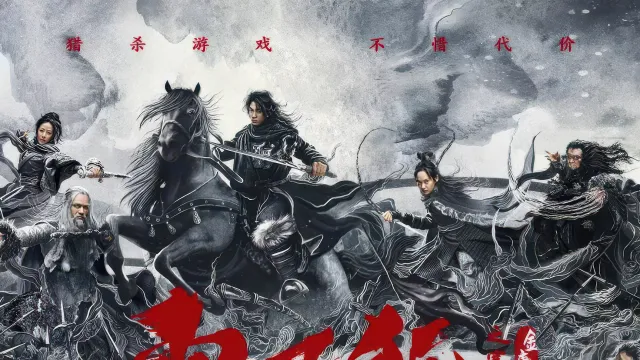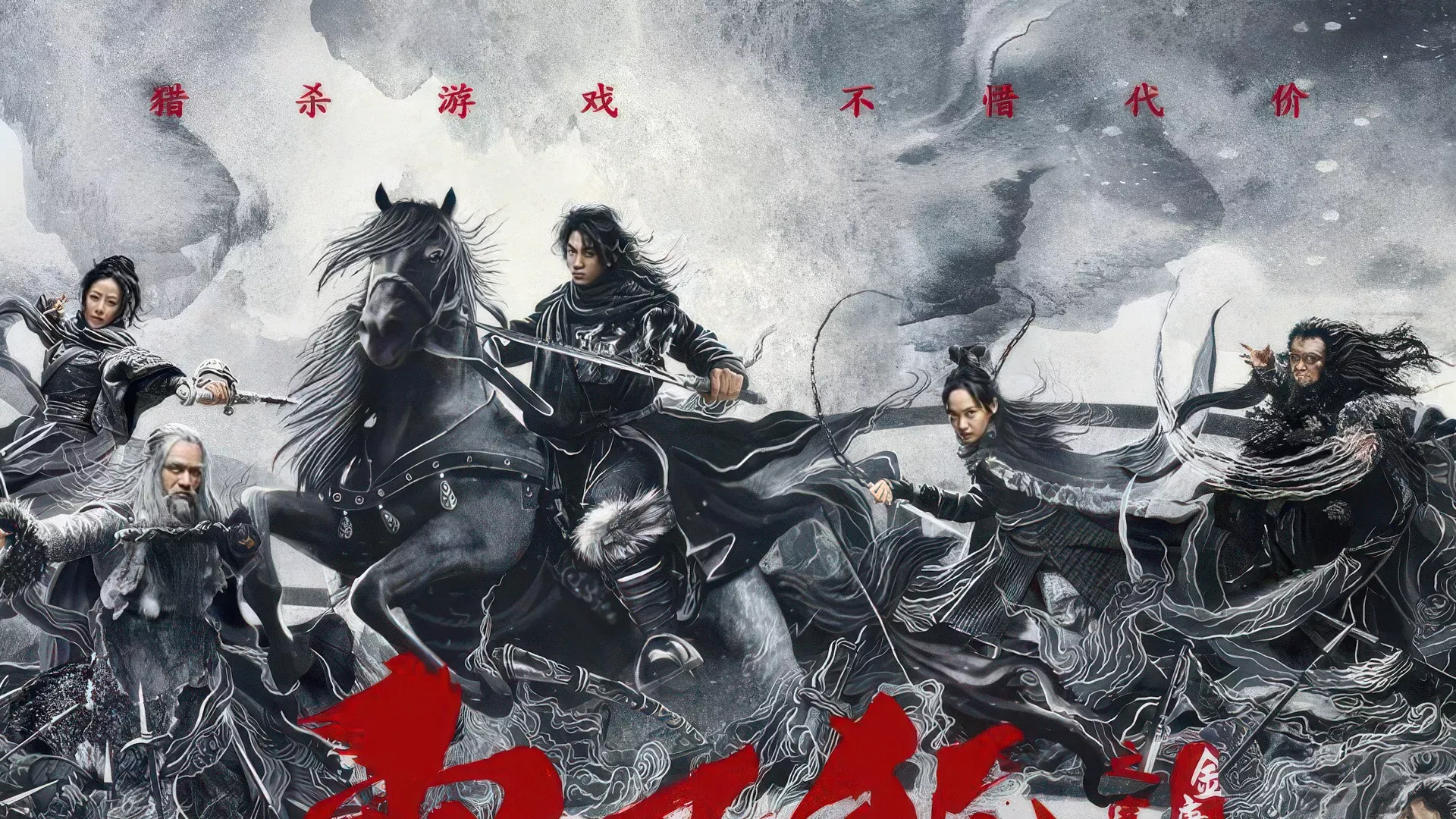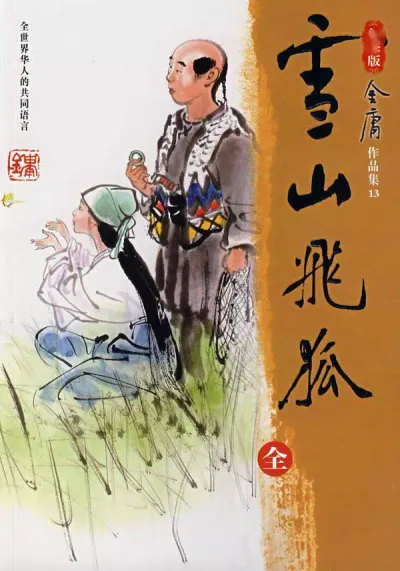Flying Fox of the Snowy Mountain (simplified: 雪山飞狐, traditional: 雪山飛狐, pinyin: Xuěshān Fēihú, Syut3 Saan1 Fei1 Wu4), also known as the Fox Volant of the Snowy Mountain is the twelfth wuxia novel by Jin Yong. It was first serialised in Hong Kong’s New Evening Post1 from 9 February to 18 June 1959.
The novel is one of Jin Yong’s shortest works at 130,359 Chinese characters. Unlike his other novels which use poetic phrases or couplets for chapter titles, Flying Fox of the Snowy Mountain simply uses numbered chapters.
The novel is unique among Jin Yong’s works for its innovative narrative structure, employing frame narrative and multiple narrators to tell a story that spans a single day but encompasses over a century of history through flashbacks. It is also one of Jin Yong’s shortest works at just 10 chapters and was later followed by a prequel, Side Story of the Flying Fox, in 1960.
Like his other works, Jin Yong revised the novel when it was published as a book in 1975 as the Second Edition. A second revision was published in early 2003 as the Third Edition.
Title translation
The title is literally flying fox of the snowy mountain. The official English translation of the novel uses Foxy Volant of the Snowy Mountain, which Jin Yong references in the Afterword.
The term “fox volant” is a more archaic and, while volant indicates a flying mammal, it loses the dynamic sense of flight that “flying fox” conveys.
It comes from Hu Fei’s nickname as the Flying Fox of the Snowy Mountain that he acquired due to his exceptional martial arts skills. “Flying” describes his incredible qinggong2 abilities, while “fox” is homonym of his surname Hu.
Plot
Background
The story takes place in China’s Changbai Mountains3 during the reign of the Qianlong Emperor4 of the Qing dynasty.5 The events unfold on a single day—the 15th day of the third month in the 45th year of Qianlong’s reign (19 April 1780).
Summary
The story unfolds on a single day in the Changbai Mountains during the Qing dynasty. The narrative begins with Tao Baishui and his son discovering a treasure chest in the snowy mountains, which contains a precious saber connected to Li Zicheng6’s rebellion. This discovery attracts various martial artists, including Master Xiong Yuanxian of the Pingtong Armed Escort, Ruan Shizhong and Cao Yunqi of the Northern Branch of the Tianlong School, and Yin Ji of the Southern Branch.
During their struggle over the treasure, a mysterious monk named Baoshu overpowers them all and forces them to travel to a manor atop Jade Brush Peak. The manor’s owner, Du Ximun, has gathered these martial artists to help him confront the legendary Flying Fox of the Snowy Mountain, Hu Fei.
Through multiple narrators and flashbacks, the story reveals the complex history behind the treasure. The saber originally belonged to Li Zicheng and was entrusted to four bodyguards—Hu Yidao, Miao Renfeng, Tian Guinong, and Fan Tianfeng. These four men were sworn brothers who protected Li Zicheng during his rebellion against the Ming dynasty7.
However, a tragic misunderstanding led to the death of Hu Yidao at the hands of Miao Renfeng during a duel. The misunderstanding arose from Tian Guinong’s scheming, who poisoned Hu Yidao’s blade before the duel. When Hu Yidao died, his wife committed suicide, leaving their infant son Hu Fei to be raised by the humble servant Ping Asi.
The story reveals that Hu Fei has grown into a skilled martial artist known as the Flying Fox of the Snowy Mountain. When he arrives at Jade Brush Peak, he meets Miao Ruolan, the beautiful daughter of Miao Renfeng. Despite their families’ bitter history, the two fall in love at first sight.
However, their romance is complicated by the ongoing feud between their families. Miao Renfeng, unaware of his daughter’s feelings, challenges Hu Fei to a duel, believing that Hu has dishonored his daughter. The situation becomes even more complex when it’s revealed that Miao Ruolan’s mother, Nan Lan, had left Miao Renfeng for Tian Guinong years ago.
The duel reached its dramatic climax when Hu Fei and Miao Renfeng find themselves stranded on a crumbling cliff. Hu Fei has an opportunity to defeat Miao Renfeng but hesitates, knowing that the man could become his father-in-law. The novel ends with this deliberate cliffhanger, leaving the outcome to the reader’s imagination.
Themes
Family and vengeance
The novel explores how misunderstandings and vengeance can perpetuate cycles of violence across generations. The feud between the four families illustrates the destructive nature of revenge and the importance of truth and reconciliation.
Love versus duty
Through Hu Fei’s relationship with Miao Ruolan and his conflict with her father, the novel examines the tension between personal desires and familial obligations.
Truth and perspective
The novel’s multiple narrators present different versions of past events, highlighting how truth can be subjective and how misunderstandings can have far-reaching consequences.
Historical legacy
The story connects personal conflicts to broader historical events, particularly through the legacy of Li Zicheng’s rebellion and its impact on later generations.
Cast
Main article: Flying Fox of the Snowy Mountain characters
Main characters
- Hu Fei (胡斐 – Hú Fěi) – The protagonist, son of Hu Yidao, known as “Flying Fox of the Snowy Mountain”
- Miao Ruolan (苗若蘭 – Miáo Ruòlán) – Daughter of Miao Renfeng who falls in love with Hu Fei
- Hu Yidao (胡一刀 – Hú Yīdāo) the Black-faced Divine – A legendary hero from Liaodong8
- Miao Renfeng (苗人鳳 – Miáo Rénfèng) the Golden-faced Buddha – A powerful martial artist
Important characters
- Tian Guinong (田歸農 – Tián Guīnóng) – A scheming martial artist who caused Hu Yidao’s death
- Ping Asi (平阿四 – Píng Āsì) – A humble man who rescued and raised Hu Fei
- Nan Lan (南蘭 – Nán Lán) – Miao Renfeng’s wife and Miao Ruolan’s mother
- Baoshu (寶樹 – Bǎoshù) – A mysterious monk with complex connections to the story
- Du Ximun (杜希孟 – Dù Xī Mèng) – Owner of the manor on Jade Brush Peak
Martial arts abilities
Main article: Flying Fox of the Snowy Mountain martial arts
- Hu Clan Bladeworks (胡家刀法) – A powerful saber technique developed by the Hu family
- Wall-climbing Gecko Technique (壁虎游墙功) – A qinggong skill used for scaling walls
- Spring Silkworm Palm (春蚕掌法) – A defensive technique with extremely short-range attacks
- Dharma Swordplay (达摩剑法) – A Shaolin sword style focusing on either pure attack or pure defense
Behind the scenes
In the revised afterword, Jin Yong addressed speculation that he had drawn inspiration from Akira Kurosawa’s 1950 film Rashomon, clarifying that he had not. He noted that similar narrative devices had been used in classical works like One Thousand and One Nights and Stories to Instruct the World.9
Publication history
The novel was first serialized in Hong Kong’s New Evening Post from 9 February to 18 June 1959. Like his other works, Jin Yong revised the novel when it was published as a book in 1975 as the Second Edition. A second revision was published in early 2003 as the Third Edition.
Chinese editions
- First Edition (1959) – Serialized in Hong Kong’s New Evening Post from 9 February to 18 June 1959
- Second Edition (1975) – Revised edition published as a book, with preface
- Third Edition (2003) – Final revised edition with preface
Adaptations
Film
- The Flying Fox in the Snowy Mountains (1964) by Emei Film Company
- The Flying Fox of Snowy Mountain (1978) by CTV (HK)
Web film
- The Hidden Fox (2022) by iQiyi production starring Zhao Huawei and Chen Yusi
Television series
Most adaptations combine this novel with Side Story of the Flying Fox into a single story. See the article on Side Story of the Flying Fox.
- 1985 TVB (HK) series The Flying Fox of Snowy Mountain
- Starring Ray Lui, Patrick Tse, Kenneth Tsang, Rebecca Chan
- 1991 TTV (Taiwan) series The Flying Fox of Snowy Mountain
- Starring Meng Fei, Mini Kung, Mu Sicheng, Tong Chun-chung, Wu Yujuan, Wang Luyao
- 1999 TVB (HK) series The Flying Fox of Snowy Mountain
- Starring Sunny Chan, Felix Wong, Wan Yeung-ming, Cheung Siu-fai, Maggie Siu, Charmaine Sheh, Joyce Tang
- 2006 ATV (HK) series Fox Volant of the Snowy Mountain
- Starring Nie Yuan, Gillian Chung, Athena Chu, Ady An, Patrick Tam, Alex Fong, Anthony Wong
- 2022 Tencent (Mainland) series Side Story of Fox Volant
- Starring Qin Jun Jie, Liang Jie, Xing Fei, Lin Yushen, Peter Ho, Ye Xiangming, Ray Lui, Leanne Liu
Radio
The 1981 Hong Kong’s RTHK ran a radio drama for 15 episodes from 8 June to 26 June from Monday to Fridays during the “Jin Yong wuxia world” segment.
It was directed by Stephen Shin.10 The production starred Ray Chan11 as Hu Fei, Zhu Manzi12 as Miao Ruolan, and Fu Qing-wai[^fuqingwei] as Miao Renfeng.
Video games
Hu Fei appears as a playable character in the 2008 PC fighting game Street Fighter Online: Mouse Generation.
Manhua
Jonesky13 released Flying Fox of the Snowy Mountain, produced by Fung Wan creator Ma Wing-shing,14 illustrated by Leung Wai-ka and Wong Shui-bun.
In 2018, a manhua adaptation was released on Tencent Comics platform.
Critical Reception
Flying Fox of the Snowy Mountain has been widely praised for its innovative narrative structure and sophisticated storytelling techniques. Literary critics have noted that the novel’s use of multiple narrators and frame narrative represents a significant departure from traditional wuxia fiction conventions.
The novel’s deliberate cliffhanger ending has been the subject of extensive critical discussion. Some critics have praised Jin Yong’s bold decision to leave the story’s conclusion ambiguous, arguing that it challenges readers to engage more deeply with the themes and characters. Others have noted that this ending reflects the novel’s broader exploration of how truth and perspective can be subjective.
Cultural Impact
The novel’s innovative narrative structure has influenced numerous later works in the wuxia genre and beyond. Its use of multiple narrators to present different perspectives on the same events has been cited as a precursor to more complex narrative techniques in contemporary Chinese literature.
The novel’s exploration of family feuds and the destructive nature of revenge has resonated with readers across different cultures. The story’s examination of how misunderstandings can perpetuate cycles of violence has been particularly relevant in discussions about conflict resolution and reconciliation.
The novel’s ambiguous ending has become one of the most discussed aspects of Jin Yong’s work, with readers and scholars continuing to debate the characters’ ultimate fates decades after the novel’s publication. This ongoing discussion has contributed to the novel’s lasting cultural significance.
Legacy
Flying Fox of the Snowy Mountain stands as one of Jin Yong’s most innovative works in terms of narrative structure. Its use of multiple narrators and frame narrative influenced later wuxia fiction and demonstrated the genre’s potential for sophisticated storytelling techniques.
The novel’s deliberate cliffhanger ending was also unusual for its time and has sparked decades of discussion among readers about the characters’ fates. This ambiguous conclusion challenged conventions of wuxia fiction and has been cited as an example of the genre’s potential for complex storytelling.
Translations
The official English translation by Olivia Mok15 was published by the Chinese University of Hong Kong Press in 1993, with a second edition released in 1996. This was the first Jin Yong novel to be translated into English.
See also
- Flying Fox of the Snowy Mountain translation
- Flying Fox of the Snowy Mountain lists
- Side Story of the Flying Fox
External links
- Fox Volant of the Snowy Mountain on Wikipedia
- Flying Fox of the Snowy Mountain (Chinese) on Chinese Wikipedia
Footnotes
-
新晚報 – Xīn Wǎnbào. A Hong Kong evening newspaper affiliated with Ta Kung Pao. See Wikipedia. ↩
-
轻功 – qīnggōng. Literally lightness skill. The ability to move with superhuman agility, and weightlessness through qi redistribution to leap over trees and roofs, and skip over water. See Wikipedia. ↩
-
長白山 – Chángbái Shān. A major mountain range in northeastern China. See Wikipedia. ↩
-
乾隆 – Qiánlóng. The sixth emperor of the Qing dynasty who reigned from 1711 to 1799. See Wikipedia. ↩
-
清 – Qīng. A dynasty ruled by the Manchu people from 1644 to 1912. See Wikipedia. ↩
-
李自成 – Lǐ Zìchéng. A Chinese rebel leader who led a peasant revolt that overthrew the Ming dynasty. See Wikipedia. ↩
-
明 – Míng. A dynasty that ruled China from 1368 to 1644. See Wikipedia. ↩
-
遼東 – Liáodōng. A historical region in northeast China. See Wikipedia. ↩
-
喻世明言 – Yù Shì Míng Yán. A collection of vernacular short stories compiled by Feng Menglong during the Ming dynasty, also known as Stories Old and New. See Wikipedia. ↩
-
冼杞然 – Xiǎn Qǐrán. A radio drama director at RTHK. See Wikipedia (Chinese). ↩
-
陳偉匡 – Chén Wěikuāng. A voice actor who played Hu Fei. See Wikipedia (Chinese). ↩
-
朱曼子 – Zhū Màn Zǐ. A voice actress who played Miao Ruolan. See Wikipedia (Chinese). ↩
-
天下出版 – Tiānxià Chūbǎn. A Hong Kong publishing house founded by Ma Wing-shing. See Wikipedia. ↩
-
馬榮成 – Mǎ Róngchéng. A Hong Kong comic artist and creator of Fung Wan. See Wikipedia. ↩
-
莫錦屏 – Mò Jǐnpíng ↩


